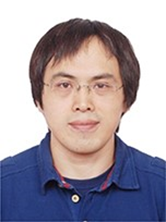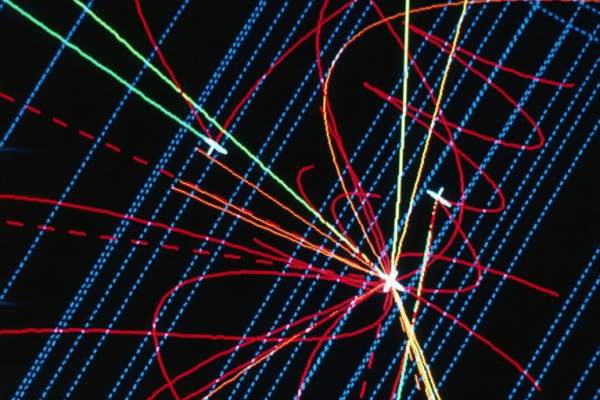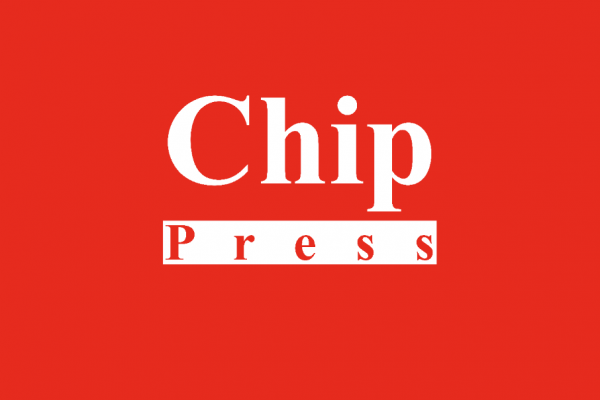Chip发表北京大学王永锋团队最新成果:超高密度低温有机存储阵列的构筑与电学操控
FUTURE远见| 2023-12-04
Future|远见
Future|远见future选编

低温随机存储器在读写速度、噪音和功耗方面表现出优越的性能。然而,将低温存储单元缩小到纳米尺度并进一步降低功耗仍极具挑战性。利用有机分子自组装形成的超高密度二维阵列构筑纳米级存储芯片有望解决这一难题。
研究团队选择了类视黄酸分子——DiA作为研究对象。DiA分子的尺寸较小,借助氢键和范德华相互作用,能够在表面组装成密排分子阵列²,³。利用扫描隧道显微镜(STM)在低温(4K)下对样品进行表征,研究团队获得了样品的形貌信息(图1)。阵列中单个DiA分子占据的面积小于0.25 nm²,使其成为构建超高密度磁性存储阵列的理想载体。

图1 | 利用有机分子DiA的自组装特性在表面获得超高密度二维有序阵列。a,阵列中最小结构单元DiA二聚体的化学结构式。b, c,DiA分子自组装结构STM形貌图。
研究团队进而利用电压脉冲成功实现了对分子自旋态的电学操纵,将分子从非磁性态转变为磁性态⁴。图2展示了分子自旋态转变前后的形貌变化和谱学演化,可以发现分子被操纵至磁性态后亮度变高,且其微分电导谱出现明显的近藤共振峰。

图2 | DiA分子的电学操纵及谱学测量。a,b,电学操纵前后分子形貌变化(标“+”处)。c, 电学操纵分子自旋态改变时的电流-电压曲线变化。d, 分子自旋转变前(黑色)后(绿色)的微分电导谱差异。
利用逻辑数字“0”和“1”分别表示分子的非磁性态和磁性态,每个分子即为一个bit,那么每八个分子可组成一个字节(byte)。通过对阵列中的目标分子bit施加电压脉冲,可以将相应的bit从“0”写为“1”,实现信息的写入与存储(图3)。每平方英寸内大约容纳2.6×10¹⁵个DiA分子,意味着基于DiA的存储芯片可以实现每平方英寸约2600 terabits的超高存储密度。这项研究揭示了利用有机分子构筑超高密度磁性存储阵列的潜力,为未来低温自旋电子器件和随机存储器件设计提供了有价值的参考。

图3 | 基于DiA分子的二维磁性存储阵列。a,b,可控调控DiA分子自旋态改变,实现信息写入。c,相对应的一个 DiA分子字节状态变化示意图。
Construction and electrical control of ultrahigh-density organic memory arrays at cryogenic temperature¹
Operating random access memory (RAM) in a cryogenic environment helps to obtain excellent performance like exceptional read-write capability, low noise and less power consumption. However, scaling of a cryogenic memory storage unit down to nanoscale and further reducing the power consumption remain challenging at present. One of the potential solutions is to construct the cryogenic memory chips with organic molecules which have the ability of self-assembling to well-ordered two-dimensional structures and constructing ultrahigh-density magnetic arrays.
In this work, the organic molecule (2E,4E)-3-methyl-5-(2,6,6-trimethylcyclohex-1-enyl)penta-2,4-dienoic acid (denoted as DiA) with small molecular size was selected to construct close-packed molecular arrays through hydrogen bonds and van der Waals force. Cryogenic-temperature (4 K) scanning tunneling microscope (STM) experiments were performed to obtain topographic images of molecular arrays (Fig. 1). A single DiA molecule in the arrays occupies less than 0.25 nm², making it a potential candidate for constructing ultrahigh-density magnetic molecular arrays.
By applying voltage pulses, we can realize the electrical control of the molecular spin states. The DiA molecule could be converted from a nonmagnetic state to a spin-carrying state. The variations in molecular topography and the differential conductance spectroscopy would reflect the changes in the molecular spin state (Fig. 2).
Utilizing logic numbers ‘0’ and ‘1’ to represent the nonmagnetic and magnetic state of the molecule, then eight molecules compose a byte of a memory chip. Each molecular bit can be converted from ‘0’ to ‘1’ by applying electrical voltage pulse to the bit sequentially (Fig. 3). Given that 2.6×10¹⁵ DiA molecules could adsorb in an area of one square inch, a memory chip constructed with DiA can reach an ultrahigh density of ~2600 terabits per square inch. The work sheds light on the potential of employing organic molecules to construct ultrahigh-density magnetic memory arrays and provides useful fundamental reference for future study of novel molecule-based spintronics and random-access memory devices in cryogenic environments.
参考文献:
1. Zhong, M. et al. Construction and electrical control of ultrahigh-density organic memory arrays at cryogenic temperature. Chip 2, 100062 (2023).
2.He, Y. et al. Observation of biradical spin coupling through hydrogen bonds. Phys. Rev. Lett. 128, 236401 (2022).
3. Karan, S. et al. Spin manipulation by creation of single-molecule radical cations. Phys. Rev. Lett. 116, 027201 (2016).
4. Bocquet, M. L., Lorente, N., Berndt, R. & Gruber, M. Spin in a closed‐shell organic molecule on a metal substrate generated by a sigmatropic reaction. Angew. Chem. Int. Ed. 58, 821-824 (2019).
论文链接:
https://www.sciencedirect.com/science/article/pii/S2709472323000254
作者简介

王永锋,北京大学教授,研究工作集中在分子电子学领域,主要包括单自旋态的检测与调控,功能有序阵列的制备以及功能化;通过表面结构的精确制备,实现量子态的模拟与计算;构筑模型催化体系,研究结构与催化性能的关系等。发表论文近100篇(包括Nature Chemistry, Nature Communications, Journal of the American Chemical Society等),主持和参与多项国家自然科学基金项目和国家重点基础研究项目。
Yongfeng Wang, Professor at Peking University, focuses his research in the field of molecular electronics. His research interests primarily include the detection and manipulation of single spin states on surfaces, the fabrication and functionalization of functionally ordered molecular arrays, and the simulation and computation of quantum states through precise preparation of surface structures. He also constructs model catalytic systems to study the relationship between molecular structure and catalytic performance. He has published nearly 100 papers on top-level journals (such as Nature Chemistry, Nature Communications, Journal of the American Chemical Society), and has led and participated in various research projects funded by the National Natural Science Foundation of China and the National Key Basic Research Program.

张雪,华南理工大学准聘教授,研究方向为基于扫描隧道显微镜的表面纳米结构制备和单分子自旋态调控及表征,在Nature Chemistry, ACS Nano, Journal of the American Chemical Society, Nano Letters等国际刊物上发表研究论文二十余篇,获得多项国家和省市科研项目支持。
Xue Zhang, an associate professor at South China University of Technology, focuses her research on the fabrication of surface nanostructures based on scanning tunneling microscopy and the manipulation and characterization of single molecular spin states. She has published over twenty research papers in famous journals such as Nature Chemistry, ACS Nano,Journal of the American Chemical Society, and Nano Letters, and has received financial support from national, provincial, and city-level scientific research projects.
关于Chip
Chip(ISSN:2772-2724,CN:31-2189/O4)是全球唯一聚焦芯片类研究的综合性国际期刊,已入选由中国科协、教育部、科技部、中科院等单位联合实施的「中国科技期刊卓越行动计划高起点新刊项目」,为科技部鼓励发表「三类高质量论文」期刊之一。
Chip期刊由上海交通大学出版,联合Elsevier集团全球发行,并与多家国内外知名学术组织展开合作,为学术会议提供高质量交流平台。
Chip秉承创刊理念: All About Chip,聚焦芯片,兼容并包,旨在发表与芯片相关的各科研领域尖端突破性成果,助力未来芯片科技发展。迄今为止,Chip已在其编委会汇集了来自14个国家的70名世界知名专家学者,其中包括多名中外院士及IEEE、ACM、Optica等知名国际学会终身会士(Fellow)。
Chip第二卷第四期将于2023年12月在爱思维尔Chip官网以金色开放获取形式(Gold Open Access)发布,欢迎访问阅读本期最新文章。
爱思唯尔Chip官网:
https://www.sciencedirect.com/journal/chip




